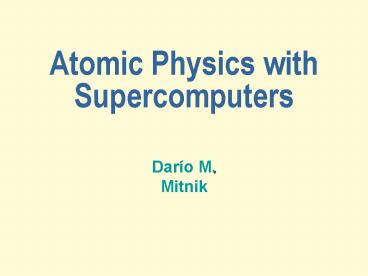Atomic Physics with Supercomputers PowerPoint PPT Presentation
1 / 55
Title: Atomic Physics with Supercomputers
1
Atomic Physics with Supercomputers
Darío M. Mitnik
2
Electron-Ion scatteringcalculations
Darío M. Mitnik
3
Atomic Physics with Supercomputers
Darío M. Mitnik
4
M. S. Pindzola, F. Robicheaux, J.
Colgan, Auburn University, Auburn, AL D. C.
Griffin, Rollins College, Winter Park, FL N. R.
Badnell Strathclyde University, Glasgow, UK
5
Outline
- What are we calculating?
- Why do we need supercomputers for such
calculations?
- How do we use the supercomputers in these
calculations?
6
What are we calculating?
- Cross Sections
- Rate Coefficients
7
Electron-Impact Excitation
N-electron ion
8
Electron-Impact Excitation
ltyafi V ybff gt
yb
ff
ya
fi
9
Electron-Impact Ionization
(N-1) electron ion
ki
EI
ya
N electron ion
10
Electron-Impact Ionization
ltyafi V feff gt
fe
ff
ya
fi
11
Radiative Recombination
ya
yb
12
Radiative Recombination
Photoionization
Mba ltyb D yafi gt
ya fi
yb
w
13
Dielectronic Recombination
Photoionization
Mba ltyb D yafi gt
ya fi
yb
w
14
Dielectronic Recombination
ya
15
Dielectronic Recombination
16
Dielectronic Recombination
D.M. Mitnik et al, Phys. Rev. A 61, 022705 (2000)
17
Dielectronic Recombination
D.M. Mitnik et al, Phys. Rev. A 57, 4365 (1998)
18
Electron-ion Recombination
D.M. Mitnik et al, Phys. Rev. A 59, 3592 (1999)
19
Excitation-Autoionization
20
Excitation-Autoionization
D.M. Mitnik et al, Phys. Rev. A 53, 3178 (1996)
21
Excitation (resonances)
22
Excitation (resonances)
D.M. Mitnik et al, Phys. Rev. A 62, 062711 (2000)
23
Excitation (resonances)
D.C. Griffin et al, J. Phys. B 33, 4389 (2000)
24
Why supercomputersin Atomic Physics?
- only a few atomic physicists are using
supercomputers
25
Why supercomputersin Atomic Physics?
- T. R. Rescigno et al., Science 286, 2474 (1999).
- M. S. Pindzola and F. Robicheaux, Phys. Rev. A
54, 2142 (1996).
- Collisional breakup in a quantum system of three
charged particles
26
Electron-Impact Ionization of Hydrogen
27
Methods
28
Time-independent R-matrix method
P. G. Burke and K. A. Berrington
27 key papers reprinted
Short Bibliography list
547 references
29
Time-independent R-matrix method
Internal Region
External Region
a
Y sin(kr) Kcos(kr)
30
Why supercomputers?
Size of (N1)-Hamiltonian MXMAT MZCHF x MZNR2
MZNC2
158 x 50 100 8000 512 Mb
31
Why supercomputers?
- Thousands of points are needed
- in order to map the narrow resonances.
D.C. Griffin et al, J. Phys. B 33, 4389 (2000)
32
Time-Dependent method
Time-dependent Schrodinger equation
33
Time-Dependent method
Time-dependent close-coupled equation
34
Why supercomputers?
16 x 250 x 250 1000000
250 x 250 62500
35
Why supercomputers?
- Time
- Memory
36
What is a supercomputer?
- Shared-Memory
- Distributed-Memory
37
Glossary
- parallelization
- functional parallelism
- data parallelism
38
Example of data parallelism
- we have 10000 cards
- we want to pick up the highest card
- each comparison takes 1 second
39
Example of data parallelism
Time (sec)
Processors
40
Example of a simple program
print, hello world stop end
call mpi_init call mpi_ rank(iam,nproc) print,
hello world, from process ,iam call
mpi_finalize stop end
41
Example of a simple program
hello world
hello world, from process 2 hello world, from
process 0 hello world, from process 4 hello
world, from process 1 hello world, from process
3
42
The R-matrix I package
- Inner-Region
- STG1 calculates the orbital basis and all
radial integrals - STG2 calculates LS-coupling matrix elements.
solves the N-electron problem.
sets the (N1)-electron Hamiltonian - STG3 diagonalizes the (N1)-electron
Hamiltonian in the continuum basis
43
The R-matrix I package
- Outer-Region
- STGF solves the external-region coupled
equations. - STGICF calculates level-to-level collision
strengths by doing
an intermediate- coupling frame
transformation.
44
Diagonalization Timing
45
Example
46
Parallelization of the external-region codes
47
Time-Dependent method
Time-dependent Schrodinger equation
Time evolution of a single-channel
48
Time-Dependent method
Initial condition for the solution
49
Initial condition for the solution
50
Time-Dependent method
51
Propagated wavefunction
52
Time-Dependent method
Projection of the wavefunction
53
Parallelization of the time-dependent codes
54
Conclusions
- Atomic Physics is still alive
55
(No Transcript)

